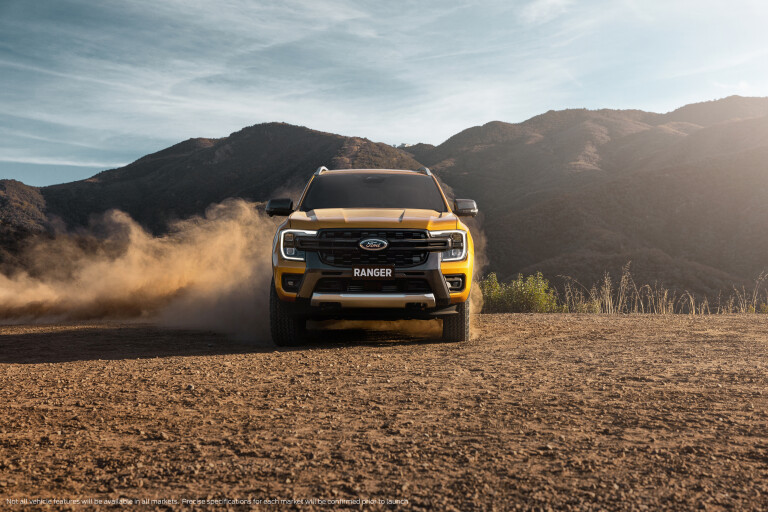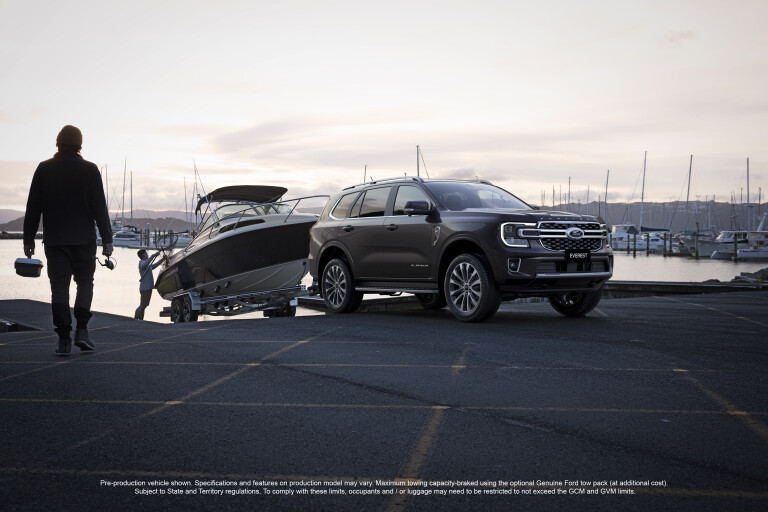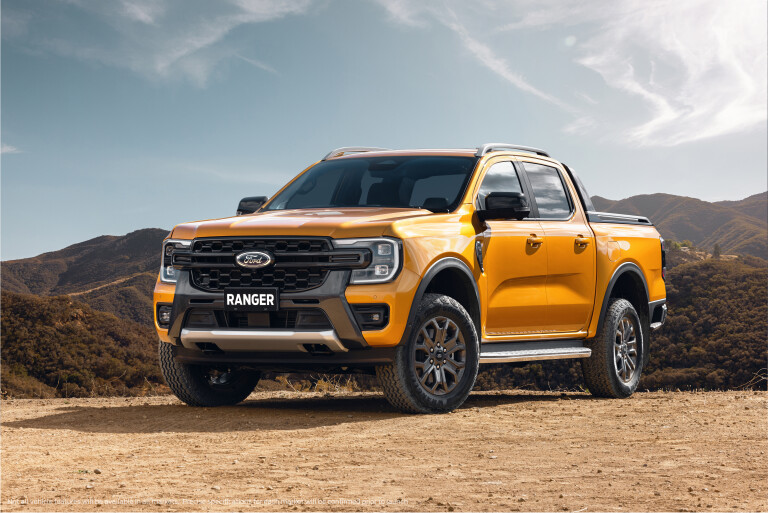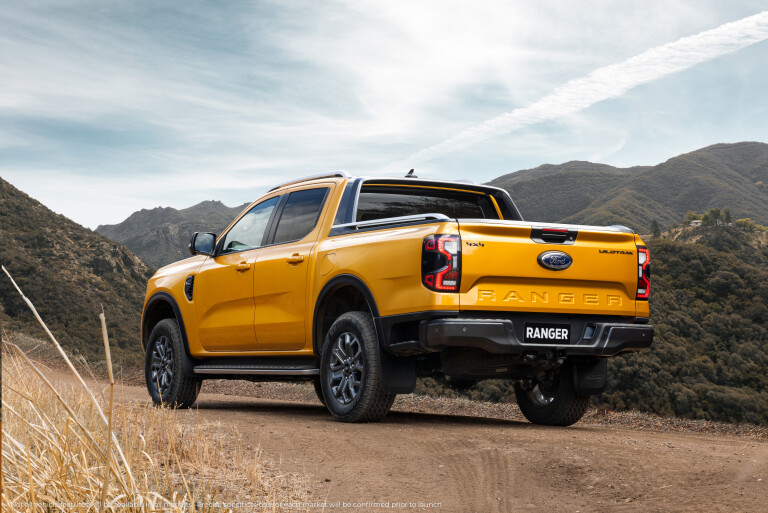
Snapshot
- V6 diesel engine to produce 184kW and 600Nm
- V6 and I4 diesel engines in regular models
- Manual gearbox axed
- 2022 Ranger orders open in April
UPDATE, July 2022: New Ford Ranger review – it's here at last
The new 2023 Ford Ranger is now on sale in Australia, and the local media launch has been run. The Wheels and 4x4 Australia teams have both driven the new Ranger, and you can find their stories at the links below.
Story continues...
UPDATE, April 7, 2022: Australian pricing for the new 2023 Ford Ranger has now been revealed. Get the full details at the link below.
The story to here
Ford has released more details of the engines that will power the next generation of Ranger ute and Everest wagon models in Australia. Specifically, it has revealed the outputs on the new 3.0-litre V6 diesel engine that will be available on upper specification models of both the 4x4 Ranger and Everest.
This latest version of the ‘Lion V6’ engine has been tuned to put out 184kW of power at 3250rpm and 600Nm of torque which will make the Ford pair the most powerful 4-wheel drive models in their respective categories.
The Lion V6 is not a new engine having first debuted as a 2.7-litre capacity in the Land Rover Discovery 3 and some Peugeot and Citroen passenger cars back in 2004. In this capacity it was even used in Ford Australia’s Territory wagon. The capacity was increased to 2993cc in 2009 and both single- and dual-turbocharger variants have been used, producing up to 700Nm of torque in some Range Rover models.

The 3.0-litre V6 was most recently used with a single turbocharger in the Ford F-150 where it was called the Power Stroke V6 and made 185kW and 597Nm, similar to what it makes for this new application for Australia.
Ford says it treated the Lion V6 like a new engine for this latest application in the T6-based vehicles – namely the Ranger and Everest, even though the outputs are similar to the F-150 specifications.
“We did a lot of application calibration and validation work in both the US and Australia to make sure it would meet the needs of Ranger and Everest customers,” said Pritika Maharaj, Ranger and Everest program manager.

“The 3.0-litre V6 turbo-diesel delivers,” added Maharaj. “When you drive a Ranger with the V6 turbo diesel, it feels strong in the sense that it’s got plenty of power and torque, which is exactly what our customers told us they wanted.”
Ford also announced more details of the payload and towing capacities. Ranger continues to have a 3500kg towing on all (both 4x4 and 4x2) variants bar the petrol-fuelled Raptor which will remain limited to 2500kg. GCM is 6350kg across the 4x4 range, but 5370kg for the Raptor.
Ford has previous revealed that the new Ranger will be well-equipped for towing with an inbuilt electronic brake controller and a clever function for checking the trailer lights without needing a second person to ‘spot’ them for you. The inbuilt safety systems such as blind-spot monitoring and rear cross-traffic alerts will also be able to account for the extra length of a trailer behind the vehicle when signalling vehicles behind you.

Interestingly, the highest payload for a V6 Ranger comes in the top-spec Wildtrak model with 997kg. This drops down to 980kg for the Sport double-cab 4x4, while in the XLT V6 it’s 995kg. This comes thanks to the higher GMV that the Wildtrak enjoys over the other models.
It appears that the V6 Ranger 4x4s are only around 58kg heavier than the I4 powered models. That’s’ going off the kerb weights of the Ranger Sport double-cab 4x4 with both engines (2300kg vs 2242kg).
As mentioned, the Ranger Raptor continues to be restricted to 2500kg towing and 753kg payload due to its bespoke suspension design which has been engineered more for off road performance than for towing and load hauling.
The Raptor will be powered exclusively by a 293kW-583NM V6 twin-turbo V6 petrol engine and will take its off-road prowess to the next level with electronic controlled Fox Racing shocks, more suspension travel, and front and rear driver-selectable locking differentials.

V6 powered Rangers and Everests will be backed exclusively by Ford’s 10-speed automatic transmission and a new full-time on-demand 4x4 system. This system is different to that in the current Everest in that it will allow users to manually lock the centre differential in 4x4 high and low range as well as offering full-time 4x4 on any road surface in auto mode.
Aside from the new V6 engines, Ranger and Everest will be offered with the now familiar 2.0-litre I4 bi-turbo diesel engine producing 154kW at 3750rpm and 500Nm from 1750 to 2000rpm and backed by the 10-speed automatic and part-time 4x4 in the Ranger and on-demand 4x4 in Everest.
A single turbocharger variant of the 2.0L diesel engine is offered in 4x2 and XL 4x4 model Rangers. It produces 125kW at 3500rpm and 405Nm from 1750 to 2500rpm and will be backed by the 6-speed automatic transmission carried over from the current generation Ranger.

Note that there is no manual gearbox offered in next generation Ranger, something that will be a disappointment to many drivers. This comes as a reflection of market demands as drivers like their cars simplified and put more importance on phone connectivity than how a car actually drives.
Four-wheel drive Rangers will all have a driver operated rear locking differential, but only the Ranger Raptor gets a front locker as well. Multi Terrain Select will now be available on more Ranger variants beside the Raptor and Everest wagon, although Ford is now calling its system Selectable Drive Modes.
There are now up to seven modes in the system: Normal, Eco, Tow/Haul and slippery for on-road use, with Mud/Ruts and Sand modes for off road. Ranger Raptor is the only variant to turn the dial up to 11 with Baja mode. These modes select the optimal calibration for systems such as traction control, transmission shifting, stability control and accelerator response to suit the driving conditions.
Ford says that the order books for the next-gen Ranger open in April even though dealers have reported huge interest and orders since the new model was revealed late last year. The company has also confirmed that the first new Ranger deliveries to customers will happen in June this year.
4x2 XL HR 2.0L single-turbo AT
| Single C/C | Super C/C | Double C/C | Double P/U | |
|---|---|---|---|---|
| Gross Combined Mass (GCM) - kg | 6200 | 6200 | 6200 | 6200 |
| Gross Vehicle Mass (GVM) - kg | 3060 | 3060 | 3060 | 3060 |
| Payload - kg | 1271 | 1167 | 1102 | 958 |
| Vehicle Tare Weight - kg | 1725 | 1829 | 1894 | 2038 |
| Kerb weight - kg | 1789 | 1893 | 1958 | 2102 |
| Maximum Towing Capacity (braked) - kg | 3500 | 3500 | 3500 | 3500 |
4x4 XL 2.0L single-turbo AT
| Double C/C | Double P/U | |
|---|---|---|
| Gross Combined Mass (GCM) - kg | 6200 | 6200 |
| Gross Vehicle Mass (GVM) - kg | 3190 | 3190 |
| Payload - kg | 1144 | 1000 |
| Vehicle Tare Weight - kg | 1982 | 2126 |
| Kerb weight - kg | 2046 | 2190 |
| Maximum Towing Capacity (braked) - kg | 3500 | 3500 |
4x4 XL 2.0L Bi-turbo AT
| Single C/C | Super C/C | Super P/U | Double C/C | Double P/U | |
|---|---|---|---|---|---|
| Gross Combined Mass (GCM) - kg | 6350 | 6350 | 6350 | 6350 | 6350 |
| Gross Vehicle Mass (GVM) - kg | 3230 | 3230 | 3230 | 3230 | 3230 |
| Payload - kg | 1327 | 1223 | 1063 | 1158 | 1014 |
| Vehicle Tare Weight - kg | 1839 | 1943 | 2103 | 2008 | 2152 |
| Kerb weight - kg | 1903 | 2007 | 2167 | 2072 | 2216 |
| Maximum Towing Capacity (braked) - kg | 3500 | 3500 | 3500 | 3500 | 3500 |
Ranger XLS and XLT
| 4x2 XLS Double P/U 2.0L bi-turbo | 4x4 XLS Double P/U 2.0L bi-turbo | 4x2 XLT Double P/U 2.0L bi-turbo | 4x4 Super P/U 2.0L bi-turbo | 4x4 XLT Double P/U 2.0L bi-turbo | 4x4 XLT Double C/C 3.0L V6 | 4x4 XLT Double P/U 3.0L V6 | |
|---|---|---|---|---|---|---|---|
| Gross Combined Mass (GCM) - kg | 6250 | 6350 | 6250 | 6350 | 6350 | 6400 | 6400 |
| Gross Vehicle Mass (GVM) - kg | 3140 | 3230 | 3140 | 3230 | 3230 | 3280 | 3280 |
| Payload - kg | 1013 | 1014 | 1003 | 1052 | 1005 | 1151 | 995 |
| Vehicle Tare Weight - kg | 2063 | 2152 | 2073 | 2114 | 2161 | 2065 | 2221 |
| Kerb weight - kg | 2127 | 2216 | 2137 | 2178 | 2225 | 2129 | 2285 |
| Maximum Towing Capacity (braked) - kg | 3500 | 3500 | 3500 | 3500 | 3500 | 3500 | 3500 |
Ranger Sport, Wildtrak and Raptor
| 4x4 Sport Double P/U 2.0L bi-turbo | 4x4 Sport Double P/U 3.0L V6 | 4x4 Wildtrak Double P/U 2.0L bi-turbo | 4x4 Wildtrak Double P/U 3.0L V6 | 4x4 Raptor Double P/U 3.0L TT V6 | |
|---|---|---|---|---|---|
| Gross Combined Mass (GCM) - kg | 6350 | 6400 | 6350 | 6400 | 5370 |
| Gross Vehicle Mass (GVM) - kg | 3230 | 3280 | 3280 | 3350 | 3130 |
| Payload - kg | 988 | 980 | 985 | 997 | |
| Payload (Max Tare) - kg | 753 | ||||
| Vehicle Tare Weight - kg | 2178 | 2236 | 2231 | 2289 | 2377 |
| Kerb weight - kg | 2242 | 2300 | 2295 | 2353 | 2431 |
| Maximum Towing Capacity (braked) - kg | 3500 | 3500 | 3500 | 3500 | 2500 |



COMMENTS